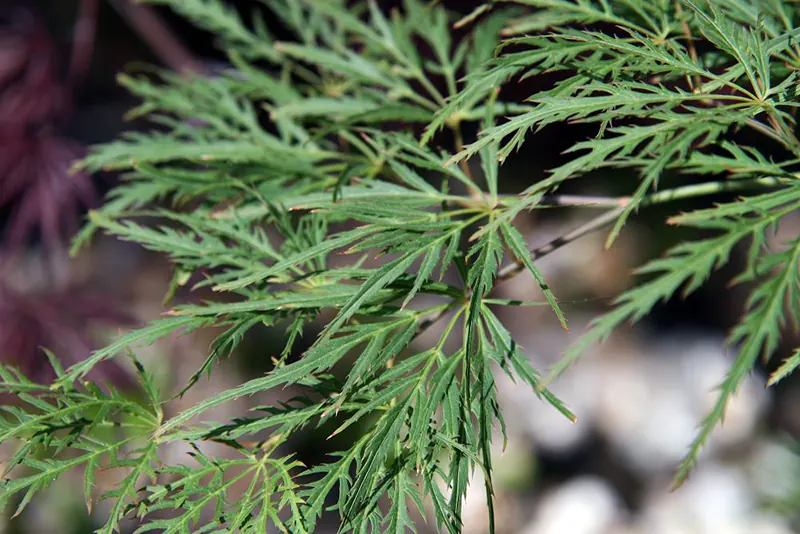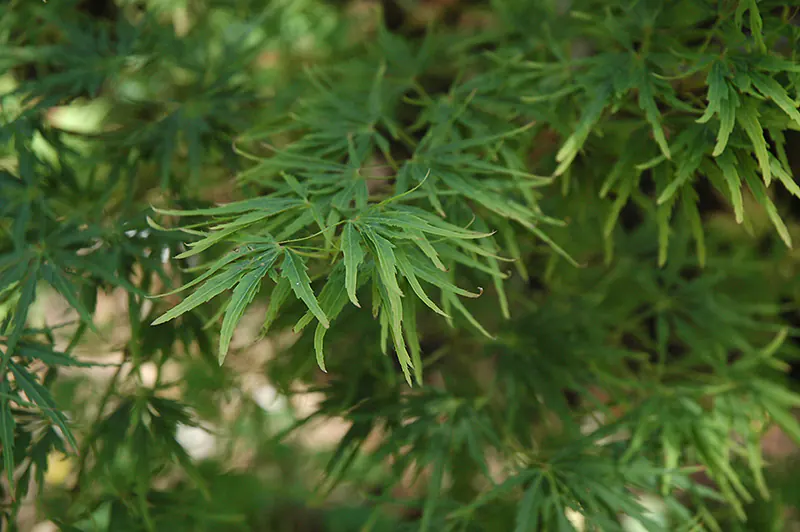Green Mist Japanese Maple | Bonsai Care Guide
Acer palmatum var. dissectum
The green mist Japanese maple is an astounding tree that’s relatively easy to begin growing. This bonsai is excellent for newcomers but best for veteran growers as it’s easy to care for but will require constant observation. The green mist needs watering at least once a day and sometimes more when the temperature rises.
Throughout this article, we’ll explore the various needs of this tree, the requirements for growing it indoors, and what you need to keep in mind when growing this tree. Additionally, we cover several frequently asked questions about this tree and the overall Japanese maple species.
Image courtesy of David J. Stang
Here's what you'll find in our green mist Japanese maple bonsai species guide:
Here's what you'll find in our green mist Japanese maple bonsai species guide:
01
02
03
04
05
Quick Green Mist Japanese Maple Bonsai Care Sheet
If you’re looking for a quick and brief overview of information, everything you need to know before growing a green mist bonsai is in the table below.
Recommended soil | An Akadama mix with pumice and lava rocks. These stones will aid the soil in draining quickly. |
Watering | Daily if not more. |
Potting season | Every second year, as the tree’s roots grow quickly at any age. |
Shaping and pruning season | Shoots and twigs can be pruned throughout the year. Larger branches need to be pruned during autumn. |
Light | Place in shade during hot weather; requires plenty of sunlight per day. |
Fertilizing | Use solid and organic fertilizers. Combine once a week with liquid fertilizers if a stronger dose is required. |
Propagation methods | Propagated with air layering during summer or seeds and cuttings through the year. |
Pests and diseases | Aphids and fungal infections such as verticillium wilt. |
How to Care for a Green Mist Japanese Maple Bonsai
The following sections will explain all the information you need to know when growing your green mist Japanese maple bonsai. This tree is relatively easy to grow, but you’ll need to pay careful attention to its watering and soil.
Best Soil
Any well-draining soil that keeps the tree’s roots healthy by not overwatering them is ideal. However, for the best option when growing your green mist maple, use an akadama mix. This soil mixture is best paired with small stones such as pumice or lava rocks which help the tree retain its moisture and drain the soil without losing nutrients.
Watering
Watering a green mist maple can sometimes be taxing, especially during warmer weather, where the soil’s moisture disappears faster. You’ll likely need to water the tree two to three times a day during these times. However, you’ll likely only need to water your bonsai once a day most of the time.
Using the akadama soil mixture with pumice and lava rocks will help the soil retain more moisture. This soil option will decrease your watering frequency compared to regular bonsai soil.
Repotting
The green mist Japanese maple’s roots will quickly grow and fill the container your bonsai is in. You’ll need to repot this tree every two years regularly. While repotting, ensure you trim down the roots.
To correctly prune the bonsai’s roots, use a pencil or chopstick to separate them gently before cutting them with sharp shears or scissors. Using this method will minimize the risk of damage to your tree.
Shaping and Pruning
This bonsai’s twigs and leaves can be pruned throughout the year during any season. This constant ability to prune allows you to maintain the tree’s style without worrying about harming it during the year. However, only cut larger branches during the autumn season to avoid damage.
When pruning large branches, a cut paste will help avoid any fungal infections with your bonsai tree. It’s essential to note that constantly pruning the leaves will strain your green mist maple. As such, it’s best to only prune in large quantities every second year.
For best growth, while pruning this tree, only cut off the leaves sparingly. These include closely spaced leaves and ones that are on the stronger areas of the tree.
Location and Sunlight
The green mist Japanese maple bonsai requires plenty of light and a well-aired environment. As such, you’ll most often want to grow this tree outdoors. Direct sunlight is usually best for this tree; however, paying attention to the climate is essential.
Once temperatures begin exceeding 85 °F, you’ll want to move the tree out of direct sunlight to avoid any damage to the plant. Additionally, this bonsai is resistant to frost but not invulnerable. When temperatures are lower than 15 °F, protect the green mist maple from the cold or bring it indoors.
Fertilizing
When selecting a fertilizer for your green mist Japanese maple, a solid organic fertilizer is the best option. This block of nutrients will slowly release itself for your tree, nourishing it as it grows.
If you’re looking for a more potent option, mix solid fertilizer with a liquid one once per week. You should only do this added dosage if your tree is already healthy and growing well. However, avoid options with a large quantity of nitrogen as this will have an adverse effect on your leaves.
Propagation Methods
Almost every method of propagation is variable for this bonsai tree. You can use cuttings or seeds to begin growing a new green mist Japanese maple at any point during the year. Alternatively, air layering is an excellent method to use during the warmer summer months.
Pests and Diseases
The most significant pest you’ll often find on the green mist Japanese maple is aphids. Fortunately, these bugs are easy to handle and can be prevented by frequently misting your tree with water. If an aphid infestation occurs, using the proper insecticide spray will eliminate these pests.
Japanese maples as a species are highly vulnerable to verticillium wilt, a fungal infection that’s lethal to your trees. Besides having no way to cure the tree, it is also contagious and spreads to other plants and bonsai. If you think your bonsai has this infection, thoroughly clean and disinfect your equipment, such as sheers and pots.
Image courtesy of David J. Stang
Considerations for Growing an Indoor Green Mist Japanese Maple
While most suited for outdoors, it’s possible to grow the green mist Japanese bonsai inside. Before you move the tree indoors, here are three things you need to consider.
Sunlight and Air
The green mist maple requires plenty of sunlight per day and can withstand direct sunlight except in summer weather. Ensure the tree receives a few hours of light each day; the more it receives, the better it will grow. You’ll need to place the bonsai near a sun-facing widow, preferably receiving morning sun to aid the tree’s survival during summer.
Fungal Infections
The green mist Japanese maple tree is prone to fungal infections such as verticillium wilt, a lethal disease. Keep your tree an adequate distance away from other plants and check it each day. If the condition occurs, it will quickly spread to other bonsai and plants if left unchecked.
Watering Frequency
Having an odd watering frequency that may require you to water it twice a day, the green mist maple is a needy tree. Placing it in an easily accessible location is best, as this will allow for easy monitoring of the soil’s dryness. Additionally, it’s advised to keep a misting bottle nearby the tree to apply water quickly and help keep pests away.
Common Issues When Caring For a Green Mist Japanese Maple Bonsai
While caring for your green mist Japanese bonsai, you’re likely to encounter two common issues that everyone faces the first time they grow this tree. Lethal infections and a lack of water are common while growing this tree, so here’s everything you need to know to tackle these issues as they arrive.
Underwatering
Touch the soil, plunging your finger deep into it to check the tree’s moisture level before each watering. This method will tell you if the tree is ready to water and should be done once in the morning and the evening or late afternoon. This daily ritual ensures you never over or underwater a growing bonsai, especially one as thirsty as the green mist Japanese maple.
Verticillium Wilt
Verticillium wilt is lethal to any tree that falls victim to it; however, you can control the infection. Keep a regular eye on the tree, trimming away any dead pieces as you see them. Use a low-nitrogen fertilizer to keep the bonsai swimming in nutrients as you water the tree on a regular basis. Additionally, keep the tree away from afternoon sunlight to prevent adding damage.
FAQs about Green Mist Japanese Maple Bonsai
Here we discuss five of the most commonly asked questions about the green mist and the rest of the Japanese maple bonsais. We’ll look at the benefits of misting your tree, if you can grow a green mist indoors, and what to do with the bonsai during the winter months. If you didn’t find the answer to a question you had in the guide, it’d be answered here.
While growing a Japanese maple bonsai, you should mist the leaves regularly. There are many benefits to misting the tree. These benefits include repelling aphids, cooling the tree down, and protecting the leaves from damage.
The Japanese maple is primarily an outdoor tree. However, it can easily thrive indoors when grown under the right conditions. You’ll need to pay careful attention to the tree’s health, its daily amount of sunlight, and how frequently you water the tree. The green mist maple requires watering at least once a day, if not more.
Place your potted green mist Japanese maple tree in a protected area during winter. A basement, unheated room, or garage is suitable. As long as the tree is kept above freezing temperatures, it’ll be safe during the winter season.
Dwarf Japanese maple trees exist and can be turned into bonsais. The options are vast and make great bonsai. These trees grow shorter and wider than regular Japanese maples.
As the Japanese maple is deciduous, it will hibernate and lose its leaves during the fall and winter months. The tree will begin growing sprouts and shoots again during spring. During this hibernation period, the tree still requires daily watering.







